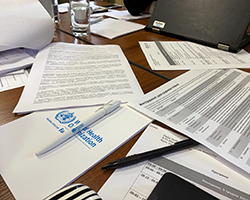Eradicating polio includes preparing for its possible return

WHO
If poliovirus were detected in your country, what actions would be taken to prevent its spread? Who would inform the public and coordinate a campaign to vaccinate vulnerable children? How many vaccine doses would be needed? How would they be procured and stored?
These questions and many more were part of polio outbreak simulation exercises (POSEs) conducted in the past month in Albania and Ukraine to review the countries’ national polio outbreak response plans and identify any gaps in preparedness.
Dr Oleksandr Zaika, Manager of Ukraine’s National Immunization Programme, explained: “This is an important and timely exercise. Critical review of the plan by experts from the Ministry of Health, the Public Health Centre, academia, and other institutions from national and oblast levels with facilitation by WHO/Europe is crucial in ensuring the preparedness of the country to a potential polio outbreak.”
The WHO European Region is polio free – why simulate an outbreak?
In October 2019, wild poliovirus type 3 was declared eradicated. This global milestone signified that, of the three wild strains, only poliovirus type 1 continues to spread anywhere in the world. However, the number of cases caused by this remaining wild strain in Afghanistan and Pakistan has increased sharply in the past year – from 33 in 2018 to 117 in 2019, as of 11 December.
A second concern is the increased detection of circulating vaccine-derived poliovirus (cVDPV) globally, with 216 human cases detected in 16 countries as of 11 December this year (up from 104 cases in 7 countries in 2018). This global trend underlines the urgency of ensuring that countries in all parts of the world are alert and ready to respond if needed.
The Global Polio Eradication Initiative’s standard operating procedures for responding to a poliovirus event or outbreak call for all countries to plan for the eventuality of a poliovirus importation or local detection. They also encourage countries to develop a preparedness plan and test it in a polio outbreak simulation exercise to ensure that public health personnel and emergency systems are prepared to react quickly and effectively if any poliovirus isolate is detected.
Lessons learned in Ukraine
The need for quick action to prevent the re-establishment of polio in Ukraine, and thereby the European Region as a whole, was demonstrated with the detection of 2 cases of cVDPV in Ukraine in 2015. The lessons learned in responding to that outbreak, which was stopped within 6 months with no further cases detected, were a main focus of the POSE conducted in Kyiv on 9–11 December 2019.
Many of the participants responsible for disease surveillance, immunization, outbreak response, vaccine regulation, communication or laboratory services were part of the response in 2015–2016 and could share valuable insights with their colleagues while reviewing the current preparedness plan.
Based on a proposed (fictitious) polio outbreak scenario, participants identified the plan’s strengths and gaps and tested its alignment with international standards. The outcome is a compilation of proposed revisions as well as a timeline and action points for their incorporation into the updated national document.
Actual earthquake during simulated outbreak in Albania
A desktop POSE was also conducted in Tirana, Albania, on 26–27 November 2019 to draft a national polio outbreak response plan and improve understanding of the critical actions needed to respond to a polio-related event or outbreak.
Participants included national policy-makers and senior technical staff from the Ministry of Health and Institute of Public Health. Their dedication to ensuring that the country is fully prepared for a polio outbreak was profoundly demonstrated during the 2-day event, as they continued with the exercise while simultaneously responding to a 6.4-magnitude earthquake that shook the country in the early morning of 26 November.



